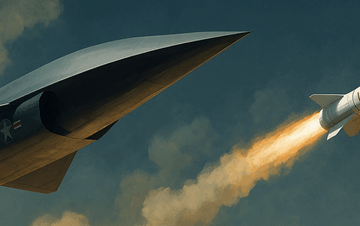Secretary of Defense Pete Hegseth’s directive to achieve “peace through strength” inherently relies on a restored warrior ethos, a rebuilt military, and reestablished deterrence. However, sustainment challenges within the Air Force—including personnel shortfalls and aging infrastructure—threaten the execution of this mission. Addressing these challenges is vital for maintaining operational readiness and strategic deterrence against pacing threats, particularly posed by nations like China and Russia.
Informed by the works of Lieutenant General Tom D. Miller, particularly “The Defense Sustainment Industrial Base” and “Capability, Capacity, and Risk in Sustainment of Air Force Weapon Systems,” it is clear that the challenges and strategies surrounding maintenance of Air Force weapon systems are multifaceted. The first article highlights the foundational elements necessary for a robust defense sustainment industrial base, emphasizing the need for a resilient infrastructure. The second publication further develops this analysis, delving into the evolving landscape of capability, capacity, and risk management in the context of sustaining advanced weapon systems. Collectively, these works offer critical insights and recommendations on optimizing the sustainment process, ensuring readiness and effectiveness in a changing security landscape.
This passage highlights a significant juxtaposition of key themes present in the Secretary of Defense’s goals and Gen. Miller’s examination of Air Force sustainment challenges. To navigate these challenges effectively, specific focus must be placed on three pivotal areas: restoring the warrior ethos, rebuilding the military, and reestablishing deterrence.
In the effort to restore the warrior ethos, the military needs skilled personnel, modern facilities, and a sustainable defense industrial base. Workforce retention and a shortage of technical expertise undeniably impact operational readiness. According to the Secretary of Defense’s mandate, there is a pressing need to “revive the warrior ethos and restore trust in our military.”
Miller’s analysis reveals that the sustainment workforce is facing severe challenges such as an aging workforce, a lack of recruitment, and significant technical expertise gaps. The Air Force Sustainment Center (AFSC) is currently experiencing a 30 percent shortage in experienced depot maintenance personnel. This shortfall adversely affects the maintenance and throughput of mission-critical aircraft. A 2022 report by the Government Accountability Office (GAO) reported that workforce shortages at Air Logistics Complexes (ALCs) contribute to an average delay of 20 percent in aircraft depot maintenance cycles, diminishing operational readiness.
Transitioning from a counterterrorism focus to one that emphasizes great power competition necessitates a sustainment workforce capable of advanced manufacturing and software maintenance, but current training pipelines struggle to produce such expertise. The implications are stark; a degraded sustainment workforce directly undermines operational readiness, particularly in maintaining high-end platforms like the F-35, which are essential for effective deterrence.
In relation to rebuilding the military, the defense industrial base faces significant hurdles due to aging infrastructure, inefficient procurement processes, and inconsistent funding. Secretary Hegseth emphasizes the importance of this rebuilding process, stating the need to match threats with capabilities. Gen. Miller’s assessments indicate that the Air Force’s sustainment infrastructure is outdated and that funding for depot modernization is inconsistent. The average age of Air Force maintenance depots exceeds 60 years, with several facilities dating back to World War II. Supply-chain vulnerabilities also arise. Significant dependence on a sole supplier for 67 percent of critical spare parts for legacy aircraft creates potential crises during conflicts. Moreover, extended procurement cycles often delay readiness enhancements, averaging 8 to 10 years from requirement to fielding for sustainment modernization projects.
Thus, without rapid modernization of sustainment infrastructure and necessary acquisition reform, the Air Force will struggle to maintain aging fleets while simultaneously integrating essential next-generation capabilities for initiatives like joint all-domain command and control (JADC2) and agile combat employment (ACE).
Reestablishing deterrence requires a comprehensive assessment of readiness to ensure that sustainment capacity effectively aligns with the threats posed by nations such as China and Russia. As stated in the SECDEF mandates, deterrence must be reestablished through defense of the homeland and collaboration with allies. However, Miller’s 2022 assessment points out a disconnect between current sustainment funding models and the operational requirements of deterrence in contested environments. For instance, from 2012 to 2022, the readiness rates for the USAF fighter fleet plummeted from 75 to 57 percent, with sustainment backlogs contributing significantly to non-mission-capable status. Only 40 percent of American sustainment infrastructure is currently forward-positioned in the Indo-Pacific, which is crucial for countering aggressive actions from adversaries.
To counter these challenges and bolster national defense strategy, courses of action should be implemented. First, revitalizing the sustainment workforce through expanded training and technological improvements is essential. According to projected outcomes, this could reduce depot maintenance delays by 15 to 20 percent within five years while raising mission-capable rates for advanced platforms.
Second, prioritizing infrastructure and acquisition reform will require streamlining procurement processes and integrating industry best practices. This reform could lead to a reduction in aircraft downtime and enhance rapid repair capabilities essential for operating within geographic regions such as the Indo-Pacific. Finally, adopting a risk-based resource-allocation strategy aligned with high-threat mission areas can significantly strengthen deterrence, ultimately raising mission-capable rates of critical platforms.
By aligning sustainment actions with the objectives of the National Defense Strategy, the Air Force can demonstrate improved deterrence capabilities, build enduring advantages, and modernize its force. An immediate investment in revitalizing the sustainment workforce, modernizing depot infrastructure, and aligning resources with operational needs is imperative. A reformative approach to sustainment is not merely an operational necessity; it constitutes a vital aspect of maintaining peace through strength. Without these necessary adjustments, the Air Force risks facing severe mission degradation in high-threat scenarios, ultimately jeopardizing national defense.
Brandon Toliver, PhD, serves on the A4 staff of Headquarters Air Force. The views expressed are those of the author and do not reflect the official guidance or position of the United States government, the Department of Defense, the United States Air Force, or the United States Space Force.





Strong Work Brandon!
What steps can be taken to attract and retain the next generation of skilled technicians to ensure long-term readiness?
Interesting. The connection between outdated infrastructure and declining readiness rates is a wake-up call. With the Indo-Pacific being such a critical region, how can the Air Force better position sustainment resources to counter threats from China and Russia effectively?
This is a fantastic analysis of the critical role sustainment plays in maintaining deterrence and readiness. The emphasis on modernizing infrastructure and addressing workforce shortages is spot on. Do you think the Air Force is doing enough to integrate advanced technologies like AI and 3D printing into sustainment operations to close these gaps more quickly?
Proud of you, Brandon! This is a powerful and timely analysis—your insight into the critical role of sustainment in maintaining deterrence and readiness is spot on. Keep leading with clarity and purpose—our nation needs voices like yours.
Anthony,
Thanks so much for the encouraging feedback! Glad the analysis on sustainment, deterrence, and readiness resonated with you. Appreciate your support and the acknowledgment of the importance of this topic.
What If Readiness Was Measured by Trust? Restoring trust in our military starts with proving we’re ready—every day, in every theater. That starts with logistics, maintenance, and infrastructure. I appreciate the emphasis on reestablishing the warrior ethos with a sustainable base. Warriors need tools. Tools need support. Support needs strategy.
Chefs kiss….measuring readiness by trust! You’re spot on that proving we’re ready starts with the basics: logistics, maintenance, the stuff that often goes unseen. It makes total sense that a strong warrior ethos needs that solid support – can’t fight effectively without the right tools being ready. It definitely makes you think about how all those pieces build confidence, both within our military and with our allies. Thanks for such pinpoint examples.
This is exactly the kind of analysis we need more of. Sustainment is where strategy meets reality.
Thanks so much! Glad you found the analysis valuable. You’re right, sustainment is truly where strategy hits the ground running. And I agree, there’s a ton of insightful content here on the Global Security Review.
Infrastructure is often overlooked in readiness discussions. It’s as critical as any weapons system. A 60-year-old depot can’t sustain 5th-gen aircraft. We need to reframe sustainment infrastructure modernization not as logistics support. Why isn’t this a strategic imperative?
Totally agree! Infrastructure is absolutely a strategic imperative, not just a support function. You can’t run a modern military on outdated facilities. It’s time we treated infrastructure modernization with the urgency it deserves – it’s as vital as the latest tech.
Brandon, your article is well researched, well written and supported by data that is “eye opening” to say the least. You and your audience have made comments pointing out issues that need to be addressed. However, the concern, mindset and culture of our country and the companies that supply equipment to our warfighters seem to be much more focused on providing their shareholders value than achieving adequate defense. The global threat is changing and we must prioritize and pivot to meet this urgent need or prepare to be victim to the very real and devastating consequence.
Thank you feedback! I’m grateful you found the article impactful, and I deeply appreciate your perspective on the critical need for prioritizing defense in the face of global threats. These are conversations we must continue to have, and I encourage you to keep engaging with the discussion—your voice and observations add immense value. Let’s work toward driving the necessary changes together!
We often measure readiness by counting tanks, aircraft, or supplies—but what about morale, leadership, and the environments our people operate in?
Esprit de corps, quality of facilities, and strong leadership aren’t just “nice to haves”—they are mission-critical.
A unit with high morale, modern infrastructure, and trusted leadership can outpace a better-equipped counterpart that lacks cohesion or suffers from neglect.
Readiness isn’t just about what we have—it’s about who we are, how we lead, and where we operate.
Are we investing enough in the people and places that make our missions possible?
Thank you for engaging so thoughtfully with the article! I deeply appreciate how different aspects resonate uniquely with readers, as you’ve highlighted a crucial point about readiness that sometimes gets overshadowed by tangible metrics. Morale, leadership, and infrastructure are, indeed, mission-critical and reflect the human and environmental elements that shape success. Your observations enrich the conversation, and I’m grateful for your perspective. Let’s continue exploring these vital investments together! Welcome the Global Security Review movement.
Thank you for engaging so thoughtfully with the article! I deeply appreciate how different aspects resonate uniquely with readers, as you’ve highlighted a crucial point about readiness that sometimes gets overshadowed by tangible metrics. Morale, leadership, and infrastructure are, indeed, mission-critical and reflect the human and environmental elements that shape success. Your observations enrich the conversation, and I’m grateful for your perspective. Let’s continue exploring these vital investments together! Welcome to the Global Security Review movement.
From Strategy to Shop Floor- connects high-level defense strategy to the operational realities on the ground.
The relationship between high-level strategy and on-the-ground operational realities is something that initially didn’t resonate with me, but your comment made it crystalize for me. I appreciate a reader who can highlight an aspect that even the author doesn’t recognize. Bridging these elements is essential for meaningful defense planning, and your comment highlights the importance of ensuring strategy translates into actionable results.
Powerful articulation of the hidden backbone of deterrence—sustainment. While shiny new platforms often steal the spotlight, the depot floors and maintenance lines are where readiness is truly forged. Gen. Miller’s insights on the fragility of our industrial base are a wake-up call. DoD needs to invest not just in tech, but in technicians.
Gen. Miller’s research from five years ago was pivotal in shedding light on the fragility of our industrial base, and his observations remain just as relevant today. Investing in technicians and the infrastructure they work within is as critical as advancing technology itself. A compelling point to ponder—where is the disconnect when a well-crafted plan on paper fails to materialize in execution? Are the issues rooted in resource allocation, organizational inertia, or perhaps communication gaps between strategists and implementers? It’s worth exploring how we can better bridge this divide to ensure plans translate into tangible outcomes. I’d love to hear your thoughts!
Modernizing Air Force sustainment infrastructure is long overdue—let’s face it, the mission can’t ride on duct tape and wishful thinking! Training programs & streamlining procurement are definitely at the top of the priority list.
I truly appreciate your engagement and hope you’ll continue to add your voice to these important discussions. Check out some of the other articles. There are some amazing writers on here giving us some real thought provoking insight!
Very informative – even for a non-technical person. Transferrable from article to practical application.
Thank you! I’m glad you found the article both accessible and practical. Most of the credit goes to the Global Security Review and the National Institute of Deterrence Studies. They have established a unique platform that fosters an open environment where ideas are freely shared. I encourage you to explore their other articles, visit the website, and connect on all social media platforms for more insightful content.
The statistics on readiness rates are concerning, especially the drop in USAF fighter fleet readiness from 75% to 57%. Investing in forward-positioned infrastructure in regions like the Indo-Pacific is critical to counter threats from adversaries like China and Russia effectively.
Spot on! The drop in USAF fighter fleet readiness rates underscores the need to prioritize sustainment efforts. This seems like a sound approach to counter threats from adversaries such as China and Russia. Strategic collaboration and innovation will be essential to bolstering readiness and ensuring security in this challenging environment. Thank you for your engagement and continue to plug in to Global Security Review. Consider sharing your thoughts!
This piece underscores the importance of aligning sustainment strategies with the National Defense Strategy. The proposed risk-based resource allocation approach is promising, but execution will require bipartisan support and consistent funding—a tall order in today’s political climate.
All critical points. Alignment is the cornerstone for ensuring readiness and effectiveness. What do you think is the best approach to garner the necessary bipartisan support? That’s a tough one… That may be worth clicking the submission link and penning your thoughts. That’s what the platform is all about.
I also encourage you to explore more articles and actively engage with them—these discussions often lead to unexpected insights and discoveries that enrich our collective understanding. Your contributions truly elevate the conversation, and I hope you’ll continue to share your thoughts!
The juxtaposition between great power competition and outdated infrastructure is striking. The Air Force must act swiftly to modernize its facilities and address supply chain vulnerabilities. Without these changes, sustaining next-gen platforms like the F-35 will remain a daunting challenge.
“You had me at ‘juxtaposition’—it’s one of my favorite words too! But seriously, you’re absolutely right. The contrast between the demands of GPC and the limitations of outdated infrastructure is a pressing issue. These changes are crucial to maintaining a strategic edge. I’m very hopeful that one the results of the pivot in approach is the catalyst for some amazing innnovation.
Thank you for engaging with this topic. Check out some of the other articles and Livecasts on the site and share the links. Let’s build our own community that allows everyone to share ideas. Reader’s insights help drive these important conversations forward—I encourage you to continue exploring and sharing your thoughts on these issues.
Secretary Hegseth’s vision of “peace through strength” is inspiring, but the challenges outlined—especially the 30% personnel shortfall—are alarming. Revitalizing the sustainment workforce with cutting-edge technologies like 3D printing can significantly improve readiness rates. This article is a wake-up call for urgent reforms.
Absolutely—what a wake-up call these past two months have been! I’m thrilled that Secretary Hegseth’s vision resonates with you. It truly underscores the need for proactive measures in defense strategy. Raising Espirit de Corps is essential to addressing the personnel shortfall, and the new SecDef is certainly energizing the conversation. Not only is he captivating to watch, but he also seems to have a clear vision and a roadmap to get us there.
Your engagement with these critical reforms is invaluable, and I hope you’ll continue to share your thoughts and contribute to these vital discussions!
The article excellently highlights the critical need for modernizing Air Force sustainment infrastructure. With aging depots and workforce shortages, it’s evident that operational readiness is at risk. Prioritizing advanced training programs and streamlined procurement processes should be top priorities to ensure mission success in contested environments.